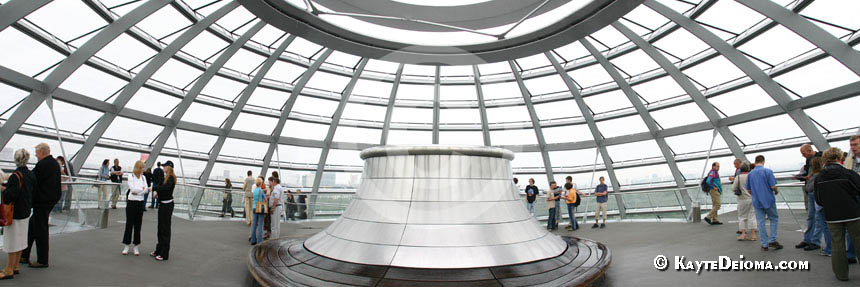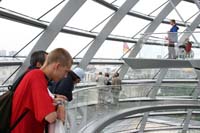 The Reichstag, the German Bundestag or parliament building, is an architectural and environmental wonder, rain or shine. On a sunny day, the wait to get into the Reichstag to visit the dome can be over an hour. This may be due as much to the time it takes to get through security and the limited capacity of the elevators as much as the occupancy limits of the dome itself. In any case, rain significantly shortens the wait, making this a good opportunity to visit the Reichstag Dome.
The Reichstag, the German Bundestag or parliament building, is an architectural and environmental wonder, rain or shine. On a sunny day, the wait to get into the Reichstag to visit the dome can be over an hour. This may be due as much to the time it takes to get through security and the limited capacity of the elevators as much as the occupancy limits of the dome itself. In any case, rain significantly shortens the wait, making this a good opportunity to visit the Reichstag Dome.
The German Reichstag is the symbol of the new unified Germany built on the ruins of the old. Built in 1884 to house the first parliament of the German Empire (Reich), it kept that function after WWI under the formation of the
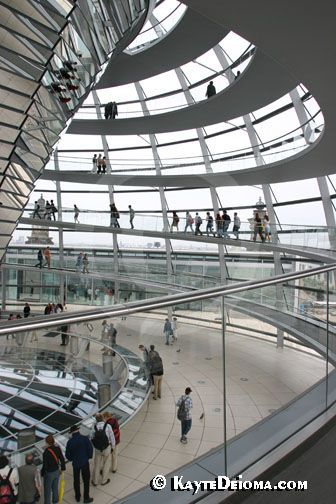 German Republic. Hitler seized power in 1933. With a fire in the Reichstag he put a quick symbolic and real end to parliamentary democracy in Germany. The ruined Reichstag building was just on the west side of the Berlin divide after WWII. The Berlin Wall, built in the 1960s, ran right along side it. It was restored to some extent, but with the new capitol of the Federal Republic of Germany in Bonn, it was used primarily for non-parliamentary purposes. After the Wall came down, when the capitol of Germany was moved from Bonn back to Berlin, the Reichstag was brought back into use for parliament business.
German Republic. Hitler seized power in 1933. With a fire in the Reichstag he put a quick symbolic and real end to parliamentary democracy in Germany. The ruined Reichstag building was just on the west side of the Berlin divide after WWII. The Berlin Wall, built in the 1960s, ran right along side it. It was restored to some extent, but with the new capitol of the Federal Republic of Germany in Bonn, it was used primarily for non-parliamentary purposes. After the Wall came down, when the capitol of Germany was moved from Bonn back to Berlin, the Reichstag was brought back into use for parliament business.
Except for the outer shell, the building was completely redesigned in the 1990s by British architect Sir Norman Foster to be environmentally and functionally efficient. The structure produces 80% of the energy needed to supply the four-building Parliamentary complex.
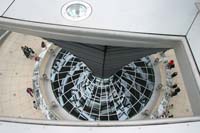 The transparent glass dome, as well as glass interior walls and glass panels looking into the plenary chamber from all sides and from above are designed to represent the transparency of the united German government. A cone of mirrors in the center of the dome, which extends through to the lower floors, gathers solar energy for heating and cooling, while reflecting natural light to the chambers below. With tourists looking on from 8 a.m. to midnight, there are no secrets here.
The transparent glass dome, as well as glass interior walls and glass panels looking into the plenary chamber from all sides and from above are designed to represent the transparency of the united German government. A cone of mirrors in the center of the dome, which extends through to the lower floors, gathers solar energy for heating and cooling, while reflecting natural light to the chambers below. With tourists looking on from 8 a.m. to midnight, there are no secrets here.
On a rainy day, you do get a bit of exposure for the few feet from the 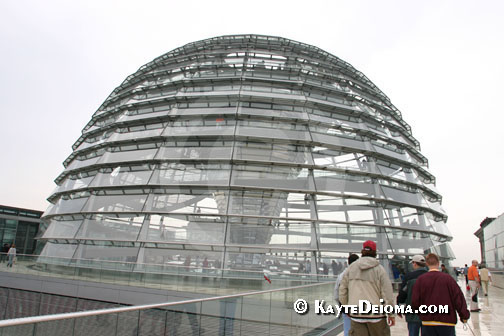 elevator to the dome entrance. Once inside the cupola, information panels around the base of the central mirrored cone provide the history of the building and its reconstruction. Between the circle of history and the central cone are glass panels, which look down into the plenary chamber when it is in session. When the chamber is not in use, these glass panels reflect back up to the dome, creating the effect of being inside a giant disco ball.
elevator to the dome entrance. Once inside the cupola, information panels around the base of the central mirrored cone provide the history of the building and its reconstruction. Between the circle of history and the central cone are glass panels, which look down into the plenary chamber when it is in session. When the chamber is not in use, these glass panels reflect back up to the dome, creating the effect of being inside a giant disco ball.
A spiral ramp gently leads you up the glass walls of the dome to a viewing platform at the top. A parallel ramp leading down keeps traffic flowing in one direction. As you climb, your eyes 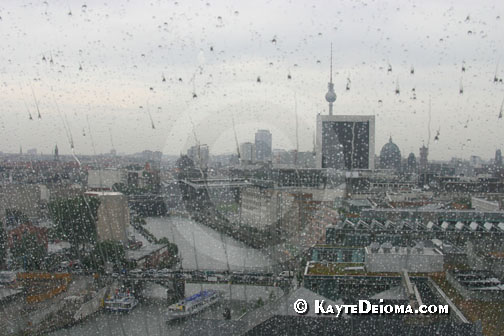 change focus through the translucent noise of the beaded water on glass to the shifting grays of the moisture-laden sky. A thick swath of the Spree River cuts through the concrete, metal and glass skyline, past the remodeled Friedrichstrasse Station. The beaded needle of the Fernsehturm (TV Tower) peeks out from behind the rectangle of the Internationale Handelszentrum ( World Trade Center). As you climb higher, the muted beige and green of the Brandenburg Gate comes into view behind the German flag flying over one of the four corner towers of the Reichstag building. A panoramic guide helps to identify a few landmarks on the horizon.
change focus through the translucent noise of the beaded water on glass to the shifting grays of the moisture-laden sky. A thick swath of the Spree River cuts through the concrete, metal and glass skyline, past the remodeled Friedrichstrasse Station. The beaded needle of the Fernsehturm (TV Tower) peeks out from behind the rectangle of the Internationale Handelszentrum ( World Trade Center). As you climb higher, the muted beige and green of the Brandenburg Gate comes into view behind the German flag flying over one of the four corner towers of the Reichstag building. A panoramic guide helps to identify a few landmarks on the horizon.
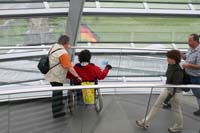 The dome is open at the top, allowing waste air from the chamber below to escape and bringing fresh air into the building. There is a circular bench in the center of the viewing platform, but since it is under the opening, it gets rained on. A better bet to find a seat out of the rain might be the Käfer Café just outside the dome, if it isn’t fully booked as it was on our visit.
The dome is open at the top, allowing waste air from the chamber below to escape and bringing fresh air into the building. There is a circular bench in the center of the viewing platform, but since it is under the opening, it gets rained on. A better bet to find a seat out of the rain might be the Käfer Café just outside the dome, if it isn’t fully booked as it was on our visit.
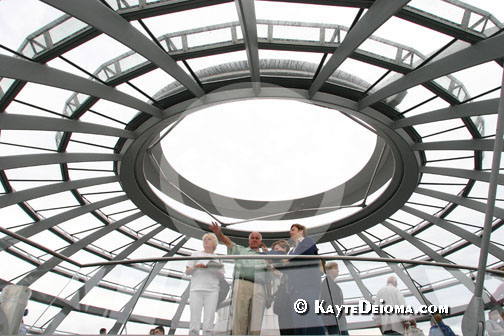 Visitors who wish to attend plenary sittings can view the proceedings from the mezzanine level that extends down into the plenary chambers like a balcony in a theatre. There is a separate line from the lobby to go up to the mezzanine.
Visitors who wish to attend plenary sittings can view the proceedings from the mezzanine level that extends down into the plenary chambers like a balcony in a theatre. There is a separate line from the lobby to go up to the mezzanine.
For more information, visit www.bundestag.de.
